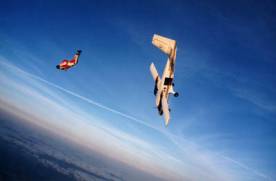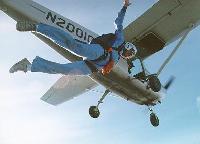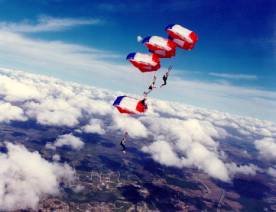
By Ayub Malik
Standing in the doorway of the plane you still feel grounded. The equipment weighs heavily on your back, the floor presses against your feet, and the straps pull on your legs and shoulders. Longing for the freedom of flight, you leap. Ten seconds after leaving the plane the wind supports you, fighting against gravity, holding you at a constant speed.
Touching nothing but air you feel the exhilarating rush of adrenaline as you soar through the sky at 120 miles per hour. You are in control; with the slightest movements of your body you alter heading, speed, and position. You and the invisible element seem perfectly in tune yet the thrill of danger sharpens your focus, slows time, and heightens your senses. Your every nerve tingles with excitement. That smooth collage of color miles below may be where you live but this is where you are most alive! For sixty seconds of eternity you are completely free of all worldly concerns; it is just you and the sky.
With only one mile left to fall the land has started moving toward you. You now have a glimmer of the immense speed at which you are traveling. As you fall below four thousand feet the Earth begins to quickly expand, rushing to meet you. Five short seconds later, a scant three thousand feet left, you open that life saving piece of cloth. The mad rush of wind suddenly transforms into the peaceful calm of a parachute ride. Slowly your ears adjust to the new volume and you hear the flapping of that beautiful fabric above your head. Eventually gravity reasserts itself; you are now below two hundred feet and the Earth is charging up, ready to swallow you. At a mere twelve feet, with a pull on the toggles, you slow your descent and gently set your feet on the ground. You have dared to defy gravity and again you have emerged victorious.
Skydiving is one of the most incredible experiences you can have! This section covers everything you need to know in order to start learning to skydive. It also has many stories and photos from experienced divers and students. Go ahead and surf around, you won't regret it.
As a skydiving virgin (and we're assuming that you are), there are several ways you can experience your first time in the air. The only requirement for jumping is that you be at least 18 years old (some drop zones allow 16-year-olds to jump with parental consent) and under 250 pounds. You should also be free of any heart or severe medical conditions says that) and, as always, if you've got something wrong with you (and we don't mean your hair) you should probably talk to your doctor before you jump. Someone who has had fainting spells, blackouts or respiratory problems should probably not be jumping and should definitely discuss this with the drop zone staff.
Most skydiving courses work the same way. Depending on
1) how much time you have
2) how much cash you've got to spend, and
3) how brave you are.
You have three options for what method of skydiving you'll use for your first jump: tandem, static line, and accelerated freefall (AFF). These offer varying levels of airborne freedom and varying levels of training time. You want to fly freely? Go AFF. Just along for the ride? Try tandem. Want to make it quick? Do static line. You decide.
Tandem : This is the most common first-timer's version of skydiving. This is probably because you don't ever have to work up the nerve to jump out of the plane - you have no choice. In this scenario, you are basically strapped onto the jumpmaster and he/she controls the jump from exit to landing. You're along for the ride, so all you have to do is enjoy the view and try not to wet your pants (it'd suck for the jumpmaster). This method requires little
preparation time - usually under an hour.
It works like this: you wear a harness that is attached to the jumpmaster's parachute system. The two of you, sandwiched together, leave the plane together and fall for about 45 seconds before the jumpmaster pulls the chute at about 4,000 feet. From there, the ride to the ground
lasts about 5 minutes.
Static Line: The static line progression is the most time-honored introduction to parachuting. On your first jump, your parachute will be opened automatically by a tether (the 'static line') attached to the airplane. You will receive extensive instruction on how to fly the parachute. Your first jump will be made from 3500 feet, and you will experience a free fall of three to five seconds. If you choose to continue your skydiving training, you will make at least four more static line jumps, perfecting your body position and your control of the parachute. You will then move on to true freefall jumps, from higher and higher altitudes, experiencing longer and longer periods of freefall. Your 'graduation jump' will be from 9000 feet, giving you 45 seconds of freefall time. The entire program of training typically involves about 25 jumps. Static line is developed by the military to drop soldiers down from the sky in a hurry, this method is also used as a first foray into skydiving. These jumps are made from about 3,000 feet and require a four-to-six hour training class. With static line skydiving, a cord attached from the plane to your parachute pulls the parachute open almost immediately after you jump out. The advantage to this method is that you don't have to pull your own rip cord. The parachute ride to the ground lasts about three minutes, during which you are directed to the ground by radio contact or ground signals. So there's still a danger, because you have to land yourself instead of letting the instructor do the work for you.
Accelerated Freefall. AFF is the most advanced program of skydiving instruction in the world. AFF Instructors are the most competent skydivers in the world--only the best even attempt the week-long Instructor Certification Course, and fewer than half pass the course and earn their rating. For the student, this means that AFF is the most intense, the safest, and potentially most rewarding way to enter the sport of skydiving. You will enjoy the complete skydiving experience from your first jump. You will exit the aircraft at 11,000 feet, with two AFF Jumpmasters holding on to either side of you. During freefall, you will monitor your altitude, watch the horizon, and perform basic maneuvers. At 4500 feet, you will pull your own ripcord and fly your own parachute to a safe landing. This is the way to go for true thrill seekers - you're as much on your own as you can be (at least for your first time in the air). You pull your own rip cord and you float to the ground solo. Of course, the training usually lasts all day, but this is the method used most frequently for those interested in becoming serious skydivers (AFF dives earn more credits toward certification than static line jumps).
Upon leaving the airplane, two instructors jump out with you, holding on to you during the entire freefall. Usually, the jump is made at about 11,000 feet, and the freefall time lasts about 45 seconds. During those 45 seconds, you have to perform three "practice pulls" in which you go through the motions of pulling your rip cord. This is done so that the jumpmasters can determine your relative sanity in the air. If you're not performing the practice pulls correctly, the jumpmaster may assume you're too nervous to do the real thing, at which time he/she will pull your rip cord for you. If you're handling the 120 mile-per-hour drop okay, you pull your cord at 4,500 feet. Either way, once the parachute is pulled, the instructors will let go of you, and you'll be on your own. The gentle sail to the ground lasts about 5 minutes, during which you're guided by radio or ground signals.
The entire course of AFF instruction consists of seven levels. Some people spend only one jump per level, but students are sometimes asked to repeat a level in order to perfect their skills. On Level II you will learn how to inspect and put on your gear, and to perform turns in freefall. On Level III your instructors will release you in freefall--you'll be flying on your own! On Level IV you will learn how to turn toward an instructor and dock on him or her. By Level V you will be jumping with only one instructor, and will perform more radical turns and maneuvers in freefall. On Level VI you will dive out of the aircraft alone (!) with your instructor diving after you. Level VII is the 'graduation dive', on which you will dive out alone, perform front and back flips, an fly away from the instructor before opening your canopy.
For all three methods, make sure you consider having your first jump videotaped. There's nothing better than looking back and feeling the nostalgia of fear as you watch your body awkwardly flip out of an airplane. To tape your jump, another skydiver jumps out of the plane before you and flies somewhere nearby with a camera mounted to his helmet.
There are five internationally recognised competitive disciplines:
Accuracy Landings
Jumping from 3,000 feet, competitors attempt to land on a 3 cm disc situated on an electronic recording surface. Distance from the disc is measured in centimetres up to 16cm. The aggregate distance over a number of rounds denotes placement with the lowest total distance placed first. The oldest of the competitive disciplines where parachute development has enabled competitors to achieve greater accuracy. Ten years ago the disc was 10cm in diameter. Today's top competitors train on a 3cm disc.
Style (Free Fall Gymnastics)
An individual free-fall event where competitors are judged on how quickly and precisely they perform set routines of loops and turns. The loneliest of all the disciplines demanding very high degrees of skill and body control similar to that needed by a top competitive gymnast or high-board diver.
Team Formation skydiving
A team competition for 4 or 8 (or more) persons. During a set free-fall time (4 way -35 seconds; 8 way -50 seconds) the team has to perform a series of predetermined formations as many times as possible. This discipline is probably the most popular at club level having developed over the past 20 years. The first World championships in were held in 1975.
Canopy Formation
Popularly known as canopy stacking this team event involves 4 or 8 persons (or more again) linking their parachutes together to form predetermined designs as many times as possible within a set time limit. This is the newest of the parachuting disciplines and it grew out of the square parachute development of the 1970s. British Teams have consistently won medals at World Championships in this event.
Paraski
An internationally recognised discipline, Paraski combines slalom skiing and accuracy landings parachuting as two separate disciplines with scores from each added to determine the winner. Landing on a snow covered slope adds a new dimension to an accuracy competition. Competition takes place at Club, Regional, National and International level allowing both men and women to compete on an equal footing - the only limits being your own determination to win. The British National Championships is an annual event involving the first four disciplines, for selection for the following year's European and World Championships. It is hoped soon that skydiving will become a full Olympic event.

Power of Gravity

First Jump Exit

Canopy Formation

Static Line Jump

First Jump with Static Line on Round Canopy, Girls between 17 to 19, Happy
With out FEAR.

Parachute Packing is also a Fun and Respect.
Back
|
|
